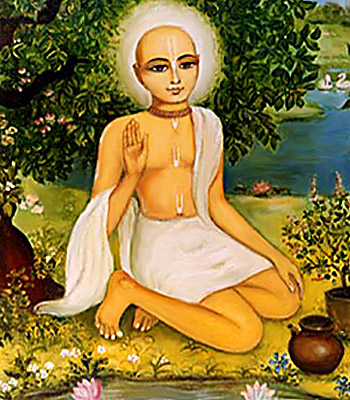 Jiva Goswami (1513-1598 AD) was a member of Six Goswamis of Vrindavan. He was the nephew of Rupa Goswami and Sanatana Goswami. He was born in Ramakeli in Malda district as the son of Srivallabha Mallika. He worshipped Lord Krishna from his childhood and completed his studies in Sanskrit Vyakarana and Kavya. The believers of According to followers of Gaudiya Vaishnavism consider Jiva Goswami to be the incarnation of Vilasa Manjari who is an eternal maidservant of Lord Krishna.
Jiva Goswami (1513-1598 AD) was a member of Six Goswamis of Vrindavan. He was the nephew of Rupa Goswami and Sanatana Goswami. He was born in Ramakeli in Malda district as the son of Srivallabha Mallika. He worshipped Lord Krishna from his childhood and completed his studies in Sanskrit Vyakarana and Kavya. The believers of According to followers of Gaudiya Vaishnavism consider Jiva Goswami to be the incarnation of Vilasa Manjari who is an eternal maidservant of Lord Krishna.
After coming to know that his father and uncles decided to work in the service of Chaitanya Mahaprabhu, Jiva desired to join them. Jiva travelled to Navadvipa in West Bengal and met with Nityananda. He took Jiva to all the holy places in Navadvipa. This marked the beginning of the Gaudiya tradition of Navadvipa parikrama.
Thereafter he went to Benares where he studied under the tutelage of Madhusudana Vidyavachaspati. Jiva also studied the six systems of Indian philosophy called Sad Darsana. He accepted initiation from Rupa Goswami and was taught the mysterious principles of devotion to Lord Krishna.
In 1542 Jiva established one of the prominent and important temples in Vrindavan, the Radha Damodara mandir. The deities of this temple had been carved by Rupa Goswami. He also established the Vishva Vaishnava Raja Sabha and the Rupanuga Vidyapitha. In 1558 Jiva instructed his students to propagate Gaudiya Vaishnavism in Bengal.
Literary contributions of Jiva Goswami
Jiva Goswami has composed twenty five works:
Hari-namamrta-vyakarana: This is a book on Sanskrit grammar where all syllable and grammatical rules are explained in relation to Krishna and his pastimes.
Sutra-malika: Sutra-malika is a grammatical work that deals with derivation of Sanskrit words.
Dhatu-sangraha: This work deals with the verb roots of Sanskrit words.
Radha-Krishna Archana Chandrika
Rasamrita-sesa: This is a Sanskrit composition that is based on Sahitya Darpana of Visvanatha Kaviraja.
Madhava-mahotsava: Here the coronation ceremony of Radha when she is given the position of Queen of Vrindavan is described.
Sankalpa-kalpadruma: This explains the eightfold daily pas times of Radha and Krishna in a prayer form.
Gopala-virudavali
: This is a short poem that extols the glories of Gopala in 38 verses.
Bhavartha-suchaka-champu
Gopala-tapani Upanishad commentary: This is a minor Upanishad that extols Krishna as the supreme God. The commentary on this text is called the Sukha-bodhini.
Commentary on Brahma-samhita: This was a Brahma-samhita that was discovered by Chaitanya Mahaprabhu at the Adi Keshava temple at Thiruvattaru during his travels in South India. The commentary of this text is known as the dig-darshani.
Commentary on Bhakti-rasamrita-sindhu: Jiva wrote his Durgama-sangamani commentary on Bhakti-rasamrita-sindhu of Rupa Goswami.
Commentary on Ujjvala-nilamani: Jiva`s commentary on Ujjvala-nilamani is known as Lochana-rochani.
Commentary on Yogasara-stavaka
Agni Puranastha gayatri-bhasya: This is a commentary on the Brahma Gayatri mantra.
Padma Puranokta Krishna-pada-padma-chihna: This describes the insignia found on the feet of Krishna.
Sri Radhika-kara-pada-sthita-chihna: Here is the description of the insignia found on the hands and feet of Radha.
Laghu Vaishnava Toshani: The Laghu Vaisnava Toshani is Jiva Goswami`s commentary to the Bhagavata Purana.
Gopala-champu: The Gopala-champu is a poetic work written by Jiva and is divided into two parts. First part is the Purva-champu which describes Krishna`s life in Vrindavan. The second part deals with the Uttara-champu and describes the pastimes of Krishna.
Sad Sandarbhas: According to Jiva Goswami the preliminary work had been done by Gopala Bhatta Goswami but it could not be completed. Jiva expanded it into six books where Chaitanya`s philosophy has been presented with scriptural evidences.
An auto commentary was also written to the Sandarbhas called Sarva-samvadini. The six Sandarbhas are:
Tattva-sandarbha: This is a treatise on various types of evidences that is used in Vedic philosophy.
Bhagavata-sandarbha: Jiva distinguishes between the Brahman, Paramatma and the Lord. The spiritual realm of Krishna is also described.
Paramatma sandarbha: This describes the super soul and how it resides in the hearts of all beings. The differences amongst the incarnations are also described.
Krishna-sandarbha: The pastimes and qualities of Krishna have been described well. Even Goloka or the planet of Krishna has also been described.
Bhakti-sandarbha: This explains how devotion to Krishna is executed. Varnashrama dharma, the position of devotion to Krishna and the worship of minor deities of the Hindu pantheon have been mentioned.
Priti-sandarbha: This is a treatise on divine love, Krishna being the supreme. Jiva makes a comparative study of different types of liberation.
Krama-sandarbha: This is a commentary on the 10th Canto of the Bhagavata Purana.
Jiva Goswami died in the year 1596. His tomb is located in the area of the Radha-Damodara temple in Vrindavan




















